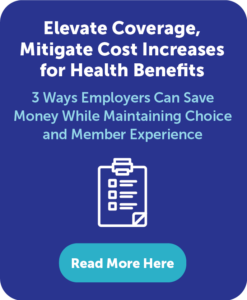by Lucent Health
Share
by Lucent Health
Share
When it comes to offering health benefits, employers may often feel as if they have to choose between two opposing goals: taking care of their employees and cutting costs. But these two goals are not mutually exclusive. It’s possible to do both well.
Prioritizing Costs
 Providing health insurance for employees has become a significant expense for most employers. In 2022, the average cost for providing a family plan was $22,463, with employers covering about 73% of that cost, according to KFF, a 12% increase over 2019, with employers covering an even greater percentage of the increased cost. And the cost of insurance for employers continues to rise, with the Centers for Medicare and Medicaid Services (CMS) estimating 5.1% cost increases through 2027.
Providing health insurance for employees has become a significant expense for most employers. In 2022, the average cost for providing a family plan was $22,463, with employers covering about 73% of that cost, according to KFF, a 12% increase over 2019, with employers covering an even greater percentage of the increased cost. And the cost of insurance for employers continues to rise, with the Centers for Medicare and Medicaid Services (CMS) estimating 5.1% cost increases through 2027.
Any business expense that steadily increases in cost every year concerns savvy leaders—and finding ways to cut costs on that item is simply smart business.
Prioritizing Employees
However, forward-thinking employers know that taking care of employees isn’t just the right thing to do—it’s also good business. Offering strong health benefits is a driving factor in recruiting top employees, and it’s even more important in retaining current employees. In a recent survey, 46% of U.S. adults said health insurance was either the deciding factor or a positive influence in choosing their current job, and 56% said whether they like their health insurance is a key factor in choosing whether to stay at their jobs.
In one of the tightest job markets in the past 50 years, with tough competition for talent, attracting and keeping top workers is an ongoing struggle. And it’s a struggle that can significantly affect the bottom line: Replacing one departing employee costs an employer about one-third of that worker’s annual salary, according to the Society for Human Resource Management.
Achieving Twin Goals
Employers that opt for self-funded health insurance plans can prioritize both employees and cost savings, without sacrificing either. Here are three important ways to do that.
Three Ways to Prioritize Both Employees and Cost Savings
- Share responsibility for healthcare decisions with employees. Employers or their healthcare management partners should stay on top of patient needs based on claims and diagnosis data, and provide individual patients with information and advice about the best providers for their particular needs to help them make informed decisions. Research shows that when patients have more information about cost and quality of care, they will seek out the least-invasive and least-expensive option.
- Choose a partner that is committed to both your employees and your bottom line. Look for a third-party administrator (TPA) that has a track record of balancing both the concerns of employees and the concerns of financial managers. The best TPA will have visibility into employer financials, including profit and loss statements. It is willing to take on this responsibility to provide strong financial stewardship, and should be able to hold costs to below expected growth. It does this by keeping fixed costs to about 15% of your total healthcare costs and by actively working to lower claims costs by managing episodes of care.
- Use data to ensure strategies are effective (and tweak if necessary). Employers or their TPAs should be using real-time workforce data to analyze the results of their benefit plans and programs. That may include multi-year evaluations of claims data, as well as employee feedback, to find out whether their initiatives helped improve employees’ health and well-being. It may also include analysis of claims to determine whether they are purchasing the appropriate level of stop-loss coverage. The ability and willingness to regularly measure results and adjust if necessary can help employers better serve their employees and cut costs at the same time.
To learn more about how self-funded health insurance plans can prioritize both employees and cost savings, visit https://lucenthealth.com.
Editor’s Note: This post was originally published in March 2020, but new research has been cited, and new information has been added.
The cost of healthcare continues to increase at an unsustainable pace, but growing price transparency is showing that employers could improve […]



